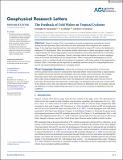| dc.contributor.author | Karnauskas, Kristopher B. | |
| dc.contributor.author | Zhang, Lei | |
| dc.contributor.author | Emanuel, Kerry Andrew | |
| dc.date.accessioned | 2021-09-30T14:35:41Z | |
| dc.date.available | 2021-09-30T14:35:41Z | |
| dc.date.issued | 2021-04 | |
| dc.date.submitted | 2020-11 | |
| dc.identifier.issn | 0094-8276 | |
| dc.identifier.issn | 1944-8007 | |
| dc.identifier.uri | https://hdl.handle.net/1721.1/132664 | |
| dc.description.abstract | Tropical cyclones (TCs) cause negative sea surface temperature anomalies by vertical mixing and other processes. Such cold wakes can cover substantial areas and persist for a month or longer. It has long been hypothesized that cold wakes left behind by intense TCs reduce the likelihood of subsequent TC development. Here, we combine satellite observations, a global atmospheric model, and a high-resolution TC downscaling model to test this hypothesis and examine the feedback of cold wakes on subsequent TC tracks and intensities. Overall, cold wakes reduce the frequency of weak to moderate events but increase the incidence of very intense events. There is large spatial heterogeneity in the TC response, such as a southward shift of track density in response to cold wakes similar to that generated by Florence (2018). Cold wakes may be important for modeling and forecasting TCs, interpreting historical records and understanding feedbacks in a changing climate. | en_US |
| dc.description.sponsorship | National Science Foundation (Awards 1854980 and 1854929) | en_US |
| dc.language.iso | en | |
| dc.publisher | American Geophysical Union (AGU) | en_US |
| dc.relation.isversionof | http://dx.doi.org/10.1029/2020gl091676 | en_US |
| dc.rights | Article is made available in accordance with the publisher's policy and may be subject to US copyright law. Please refer to the publisher's site for terms of use. | en_US |
| dc.source | Prof. Emanuel | en_US |
| dc.title | The Feedback of Cold Wakes on Tropical Cyclones | en_US |
| dc.type | Article | en_US |
| dc.identifier.citation | Karnauskas, Kristopher B. et al. "The Feedback of Cold Wakes on Tropical Cyclones." Geophysical Research Letters 48, 7 (April 2021): e2020GL091676. © 2021 American Geophysical Union | en_US |
| dc.contributor.department | Massachusetts Institute of Technology. Department of Earth, Atmospheric, and Planetary Sciences | en_US |
| dc.relation.journal | Geophysical Research Letters | en_US |
| dc.eprint.version | Final published version | en_US |
| dc.type.uri | http://purl.org/eprint/type/JournalArticle | en_US |
| eprint.status | http://purl.org/eprint/status/PeerReviewed | en_US |
| dc.date.updated | 2021-09-29T15:32:11Z | |
| dspace.orderedauthors | Karnauskas, KB; Zhang, L; Emanuel, KA | en_US |
| dspace.date.submission | 2021-09-29T15:32:13Z | |
| mit.journal.volume | 48 | en_US |
| mit.journal.issue | 7 | en_US |
| mit.license | PUBLISHER_POLICY | |
| mit.metadata.status | Complete | en_US |
